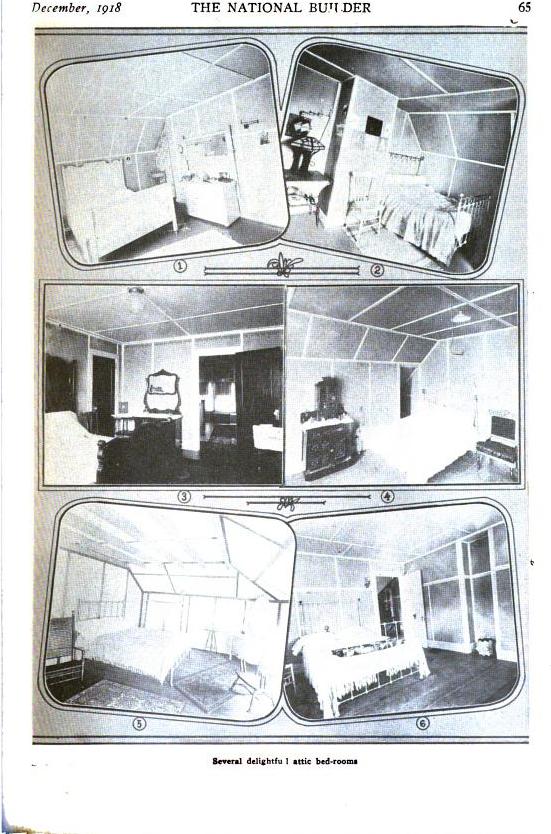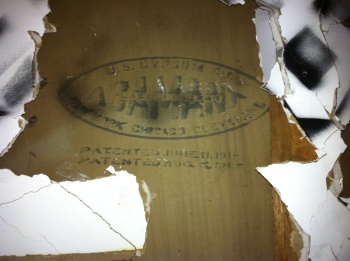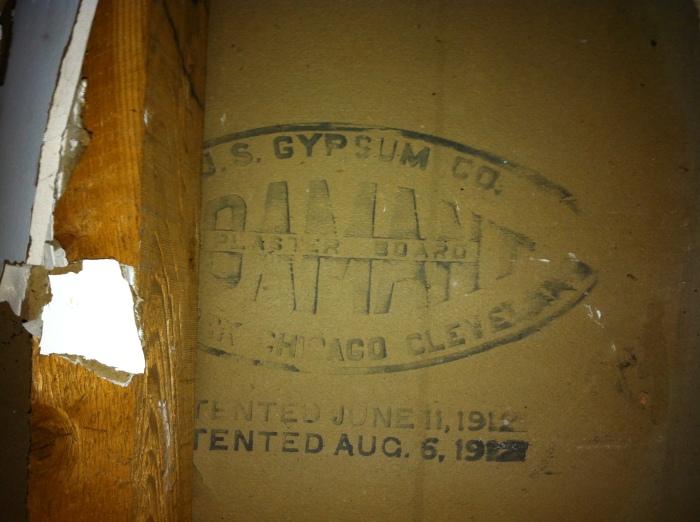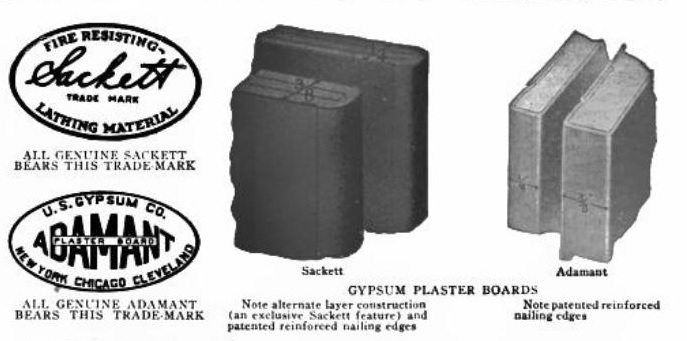Recently I came across a building product I had never seen before. Several openings were made to a drywall wall and the back of the opposite drywall panel was visible, along with some manufacturers’ stencils that read:
U.S. Gypsum Co.
Adamant Plaster Board
New York Chicago Cleveland
Patented June 11, 1912
Patented Aug. 6, 1912
I had seen those patent dates before on gypsum wallboard products, but I was not familiar with ADAMANT Plaster Board. What is ADAMANT Plaster Board? With a little creative research I learned that ADAMANT board was a pretty big deal as it was the beginning of the end for lath and plaster walls. It is an early incarnation of US Gypsum’s “Sheetrock” and not a rock lath like gypsum lath board base for plaster as I thought that it might have been.
In 1909 the US Gypsum Company (USG) purchased the Sackett Wall Board Company. Sackett’s primary product was a material called “Sackett Plaster Board” (patented in 1894) that consisted of alternating layers of wool felt and gypsum and was an impressively fireproof material. Sackett board was not a finish wall material but was a lathing material, one that required a layer of gypsum plaster to be applied as the finish surface. For several years after the purchase USG continued the use of the trade name Sackett Plaster Board. USG began developing a wall board that could be applied as a stand alone finish surface and did not require being covered with plaster. By 1916 a successful product had been developed and was being marketed. This product was coined ADAMANT Plaster Board. The brand name ADAMANT had been used previously by US Gypsum for their line of high-end gypsum plaster finishing products, and was the name that USG hoped would be synonymous with a finish wall product.
Unfortunately for USG the name wasn’t working to move their product.
According to USG, sales representative D.L. Hunter of Fort Dodge, Iowa suggested the name “Sheetrock.” Both “Sheetrock” and “ADAMANT” board products were advertised in the same 1920 Sweet’s Catalog but the name ADAMANT Plaster Board was playing second fiddle to the new brand name and likely was put to bed by the end of that year. So our examples are from a very narrow window of time c.1916-c.1918 for manufacturing dates and assuming it was not new old stock, was installed during the same time period. My understanding of the development of joint compound and tape is a little bit shaky, the products might not have been offered by USG until mid 1920. Since these products were unavailable when ADAMANT board was being applied, strips of wood lath were used to cover the joints. This treatment can be seen in the photos featured in a December 1918 article in The National Builder magazine.

“The Attic is a Ready Source of Work” article by Harry Male from The National Builder magazine December, 1918.
ADAMANT board is fire resistant and was part of the nationwide sanitary and fire proofing push at the turn of the 20th century. ADAMANT board does not contain asbestos, (none of USG drywall products contain asbestos but some other USG compounds do) so your chillins and your old people are safe from mesothelioma.
The stencil on our example boards have two patent publication dates from the year 1912. June 11, 1912 was the issuance date of the patent for new and useful improvements to the machine that produced the gypsum board. This machine had been used to produce Sackett and other USG gypsum boards that would be used as a sheet lath base for a top coat of plaster. Aug. 6, 1912 was the issuance date of the patent for gypsum board itself, specifically a board that had paper wrapped edges. The paper wrapping of the edges gave strength to the board during handling and installation, and for when nailing near the edges of the board. This was paramount to the stand-alone wall finish system. Since the board was the finish surface, any damage to the board would not be covered up by plaster and would be visible.
I hope this example of a Sheetrock predecessor has been informative. This ADAMANT board installation is the earliest documented drywall I’ve knowingly laid eyes on and it is certainly the oldest stand alone gypsum wall finish system I’ve seen. I always enjoy finding manufacturers’ stencils to glean a nugget of information from. Some period documents state each 32″x 36″ Sackett Plaster Board has a manufacturers’ stencil that reads “Sackett Patented May 22,1894.” I hope someday I can find and share an image of such a stencil with you.
Categories: Architectural Research, Historic Preservation




I think this is the fun part in renovation work–seeing the guts of the building, and finding surprises like this. Of course, in re-doing our shower, we found “surprises” that were not nearly as pleasant. :)
LikeLike
Katrina provided us with so many of those opportunities. I suppose when life hands you lemons you best make lemonade, but I would rather have all the buildings back.
LikeLike
I’ve come across several examples of a board with regularly-spaced holes. The room-facing side had a screed of plaster that Infilled the holes and beyond, which formed created keys. I’ve never been certain why this system existed. Perhaps to avoid the plaster from crazing? But that seems weird.
LikeLike
Yes that material is Rock Lath. One of the popular posts from way back in 2012 was “What is rock lath?”
https://misspreservation.com/2012/04/19/the-real-rock-lath-of-jackson-county/
The holes (& created keys) are to more firmly adhere the plaster to the lath board. Plaster crazing is more related to how quickly the plaster mix cures.
LikeLike
My entire house is made primarily of this… built in 1945. Hard as a rock and hard as heck to patch.
LikeLike
Interesting for 1945. Are you sure it isn’t rock lath? https://misspreservation.com/2012/04/19/the-real-rock-lath-of-jackson-county/
LikeLike
I’m in the process of renovating a home that we just purchased in the Burlington, VT area. I was fascinated by the ADAMANT stamps that I found during demolition. We are saving and framing at least one – It’s a shame to throw that history in the dumpster.
Thanks for your article and research!!
LikeLike
I live in NY. I’m renovating my barn, behind the wainscoting is the sackett board I can’t attach a picture but we have a good one of the label on the board
LikeLike
Wow sounds like quite the fancy barn with both sackett board and wainscoting. If you email the images to me @ thomasrosell at misspreservation.com I can share the files on here, or you can share them on our Flickr page.
LikeLike
We just started renovation to our living room and dining room. We found board with the stencil “trade market Sackett June 12,1912, August 6, 1912. Unfortunately I can’t seem to copy the photo in this reply.
LikeLike
Very cool! If you send it to ThomasRosell @ misspreservation.com I can share the image on the page.
LikeLike
We just found some early sackett board labels in a house I’m restoring. I’d leave a picture but can’t post them.
LikeLiked by 1 person
You can post a link if you upload them to a photo sharing site or if you email them to me I will post them.
LikeLike
My ceiling fell in my living room. I came across a piece with “plaster board may 22nd 1894” stamped on it. I have a picture if you want it
Frank
LikeLike
Sure. If you’d like to share it you can send it to thomasrosell @ misspreservation.com
What state is your living room located in?
LikeLike
For those interested in the photograph
LikeLike
I have a photo of the Sackett manufacturers stencil. Not sure how to upload it.
LikeLike